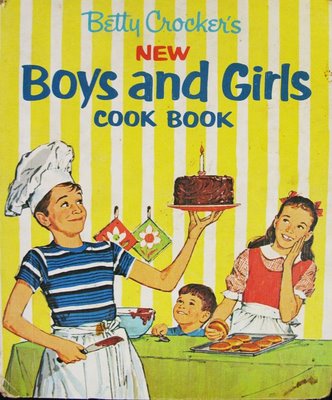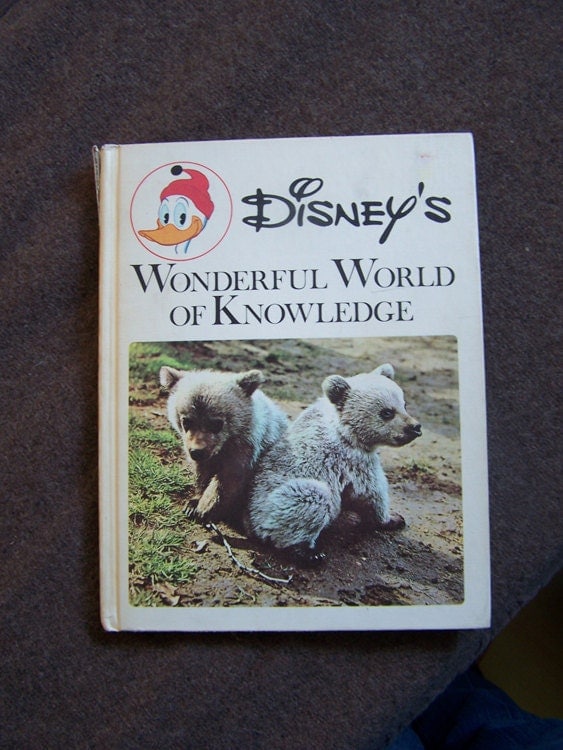 Illustrated by Gloria Kamen
Illustrated by Gloria Kamen
(Golden Press, 1965)
This is the first of a
week-long focus on an oft-overlooked nonfiction category, cookbooks for
children.


Aside from a couple of series (i.e., Thornton W. Burgess’s animal adventure books and Encyclopedia Brown mysteries), fiction wasn’t my thing when I was a kid. I wouldn’t say I was a big on nonfiction, but it was my preference by default. I frequently browsed through my Britannica Junior and Disney’s Wonderful World of Knowledge encyclopedia sets, I memorized facts on my hockey cards and I regularly consulted our two daily newspaper subscriptions, expanding my must-skim sections over time. And then there was one other pivotal book from my childhood, the spiral-bound Betty Crocker’s NEW Boys and Girls Cookbook. (Curiously, there is a space separating cook and book on the cover, but not on the title page. One would think a copy editor would have caught the inconsistency.)
This 1965 book follows the highly successful first
children’s cookbook, published in 1957.
One of the selling points for both books was that all the recipes had
been tested and regarded favorably by children who served as
“test-helpers”. Considering the time
period, it is remarkable that nine of the twenty-five children are boys. (After all, a few years later in junior high,
I would be gender-tracked, suffering through all-boys Woodworking while the
girls studied Home Ec.) Truer to the
times, all the children, based on their sketched portraits, are white with
typical English names like John, Joan, Ricky and Chris. As well, there is no cultural diversity in
the recipe list: no hummus, no Greek
salad, not even nachos. This is a book
that considers iceberg lettuce, hotdog wieners and fruit cocktail as staples.
The opening section, “What Every Cook Should Know”, contains
some must-read retro advice on staging a meal.
Under the heading “Setting the Table”, Betty states that family meals
should “[a]lways have a centerpiece—garden flowers, fruit, a little pot of ivy
from the window sill, or a figurine from the cupboard shelf.” (TO DO
this weekend: Scour through garage sale
heaps in search of figurines for my cupboard shelf. (PLAN B:
Bring in one of my beloved garden gnomes.)) Betty schools the reader on good manners,
with tidbits like “Wait to begin eating until Mother is seated and all the
family has been served” and “Wait until everyone has finished before you ask to
be excused from the table. When you are,
tell Mother ‘Thank you.’” In our home,
Betty would have been proud. With
nostalgic sadness, I read “Fun at Dinnertime” where Betty reminds us of the
lost art of communication over family dinners:
Dinner is the sociable meal of the day when
all the family gathers
around the table together, and everyone
tells what happened at
school, at work, and at play.
Betty adds, “Talk about happy subjects” and suggests a
conversation game called “Table Topics”.
Yes, let’s have families talk, but let’s not have it get too real.
 As a boy, I salivated over the recipe for Polka-dotted
Macaroni and Cheese (the dots are sliced frankfurters liberally tossed on a
casserole dish of macaroni topped with “cheddar cheese soup”—is there such a
food item anymore?). Even then,
however, Meat Loaf à la Mode was an instant reject. No way a scoop of mashed potatoes suffices as
a fill-in for ice cream! And speaking of
turnoffs, the Italian Pizza, consisting of no spices and chopped onion as the
only veggie, risked steering a generation of youngsters away from the World’s
Greatest Food. The unappetizingly drab
photograph did not help. These were the
days before anyone dreamed up “food stylist” as an occupation. (Test-helper Mary Sarah shares the thinking
of the time in the beginning of the book, “Mother showed me how to cut parsley
and put it on top of soup. It looked
pretty there.”)
As a boy, I salivated over the recipe for Polka-dotted
Macaroni and Cheese (the dots are sliced frankfurters liberally tossed on a
casserole dish of macaroni topped with “cheddar cheese soup”—is there such a
food item anymore?). Even then,
however, Meat Loaf à la Mode was an instant reject. No way a scoop of mashed potatoes suffices as
a fill-in for ice cream! And speaking of
turnoffs, the Italian Pizza, consisting of no spices and chopped onion as the
only veggie, risked steering a generation of youngsters away from the World’s
Greatest Food. The unappetizingly drab
photograph did not help. These were the
days before anyone dreamed up “food stylist” as an occupation. (Test-helper Mary Sarah shares the thinking
of the time in the beginning of the book, “Mother showed me how to cut parsley
and put it on top of soup. It looked
pretty there.”)
I recall following the chocolate chip cookie recipe to
provide a surprise treat for my parents after they left me unsupervised for a
few hours as a nine year old. (There was
so little to fear back then. No AMBER
ALERTS, no internet reports of children abducted and entrapped in far off
Belgium. All hysteria was reserved for
testing whether laundry detergent could remove grass stains from little boys’
jeans.) Back to my cookie recipe,...the
ingredient “½ teaspoon soda” perplexed me.
Soda? Coke or Pepsi? In cookie dough?! I skipped that part and presented my parents
with baked goods guaranteed to knock out a few teeth. Lesson learned and emergency dental visit
miraculously averted.
I think I stared at the ice cream sundae pages the
most. If only my parents stocked our
freezer with something other than no-name Neapolitan. “Special Occasions” represented the second
most flipped to section. In addition to
festively decorated desserts for Halloween and Christmas, Betty provided handy
notes for a “Big Top” Party, complete with directions for place card balloons,
Popcorn Ball Clowns and a heavily candied Circus Parade Cake. I never tried to carry out a circus party—too
much work—but I imagined becoming everyone’s best friend if only my mom would
do it all.
I tried very few of the recipes, but gazing at and reading
about recipes that Betty believed I could handle proved infinitely more
entertaining than cracking open good-for-you Newbery Medal novels or
yet another Hardy Boys book my grandparents bought for my birthday. Betty
Crocker’s Boys and Girls Cookbook established a habit I still follow
today. Now a vegetarian, I regularly
purchase cookbooks and foodie magazines, thumbing through the pages, gazing at
the photos, visualizing the steps for particularly enticing recipes and then
relegating the reading material to a kitchen cupboard stuffed with unrealized
dreams. I can read about Mars and never
go there; same with oven adventures involving concoctions admittedly several
notches more enticing than Butter Sticks and Fruit Basket Upset. To this day, soup from a can seems so much
more sensible.
No comments:
Post a Comment